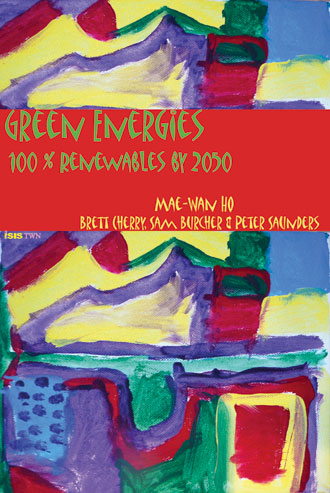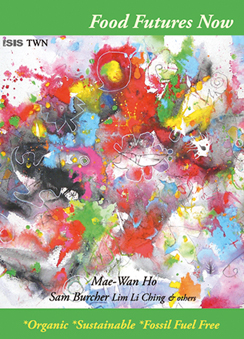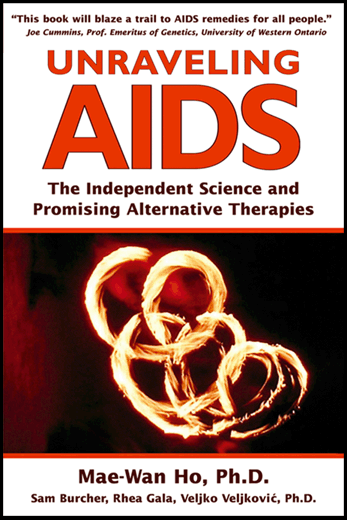- Details
- Hits: 2108
By Mae-Wan Ho, Sam Burcher, Brett Cherry, & Peter Saunders
“A must-read for saving the climate”
 The world can be 100 percent renewable by 2050.
The world can be 100 percent renewable by 2050.
- A variety of truly green and affordable options already exist, and more innovations are on the way
- Policies that promote innovations and stimulate internal market for decentralised distributed generation are key
In 2008, for the first time, more renewable energies capacity was added globally than conventional energies, and the trend continues
Wind energy alone can supply 40 times the world’s electricity or 5 times its total energy consumption. PV technologies are improving by leaps and bounds, and electricity from solar panels is already as cheap as electricity from the grid. Biogas from wastes has transformed rural China, and waste-incinerating community cookers poised to do the same in Africa. Air condition and energy from deep water, saline agriculture for food and fuel, and estuarine reef for tapping tidal energy are further options in addition to well established micro-hydroelectric and geothermal energies.
Promising developments on the horizon include thermoelectrics for recycling waste heat into electricity, artificial photosynthesis for harvesting and storing solar energy, and the potential for solving our nuclear waste problem by low temperature transmutation.
These are exciting times. All we need to save the planet is for our leaders to follow the way of nature and the will and wisdom of the people.
350 PPM THE NEW TARGET
Global warming is happening much faster than the IPPC (Intergovernmental Panel on Climate Change) predicted in its latest 2007 report. For one thing, its climate models failed to account for the rapid summer melting of the polar ice caps that’s been making headlines several years in a row.
The IPCC helped set the target of 450 ppm maximum of atmospheric CO2, which they thought would limit the global temperature rise to below 2 ˚C, and prevent “dangerous anthropogenic interference with the climate system.”
But top climate scientists Jim Hansen and colleagues, using more realistic climate models and key data from the remote history of the earth, showed that 450 ppm is well beyond the danger zone, and we must even reduce the current 385 ppm atmospheric CO2 down to 350 ppm, or else face “irreversible catastrophic effects” [1]. And the head of IPCC Rajendra Pachauri now agrees [2].
The good news is that we can still do it. It is not too late. All it takes is to stop burning fossil fuels in order to bring 385 ppm back down to 350 ppm within the next decades. But we must act now, because 385 ppm is already within the danger zone, and we cannot afford to let it remain there for too long, or we push the planet past the point of no return.
That is why we need to commit ourselves to truly green energies as a matter of urgency
- Details
- Hits: 2383
*Organic *Sustainable *Fossil Fuel Free Mae-Wan Ho, Sam Burcher, Lim Li Ching & others
 How organic agriculture and localised food (and energy) systems can potentially compensate for all greenhouse gas emissions due to human activities and free us from fossil fuels.
How organic agriculture and localised food (and energy) systems can potentially compensate for all greenhouse gas emissions due to human activities and free us from fossil fuels.
“Most compelling! A succinct and pithy appraisal of the current state of the planet - and just the right resolutions.” Sir Julian Rose, a leading exponent of organic farming, Chair of the Association of Rural Businesses.
“This excellent and timely report makes clear how vital it is that we make the right choices on how to produce and distribute our food in tackling climate change, and what those choices should be.” Dr. Caroline Lucas, Member of the European Parliament.
Highlights
- The largest single study in the world in Ethiopia shows composting gives 30 percent more crop yields than chemical fertilizers
- Scientists, too, find organic out yields conventional agriculture by a factor of 1.3, and green manure alone could provide all nitrogen needs
- Local farmers in Sahel defied the dire predictions of scientists and policy-makers by greening the desert and creating a haven of trees
- Organic urban agriculture feeds Cuba without fossil fuels
- Organic agriculture and localised food systems mitigate 30 percent of the world's greenhouse gas emissions and save one-sixth of energy consumption
- Anaerobic digestion of farm and food wastes in zero-emission food and energy farms could boost total energy savings to 49.7 percent and greenhouse gas savings to 54 percent
- Cleaner, safer environment, greater biodiversity, more nutritious healthier foods
- Higher income and independence for farmers, more employment opportunities
- Regenerate local economies, revitalize local, indigenous knowledge, create social wealth
- Details
- Hits: 2328
The Independent Science and Promising Alternative Therapies
Mae-Wan Ho, Sam Burcher, Rhea Gala and Vejko Velkovic
 AIDS (Acquired Immune Deficiency Syndrome) was identified as a global pandemic and “a threat to world security” by the Clinton administration in July 2000. President George W. Bush pledged $15 billion to combat AIDS, and additional hundreds of millions of dollars have been donated by rich countries and charitable foundations.
AIDS (Acquired Immune Deficiency Syndrome) was identified as a global pandemic and “a threat to world security” by the Clinton administration in July 2000. President George W. Bush pledged $15 billion to combat AIDS, and additional hundreds of millions of dollars have been donated by rich countries and charitable foundations.
Yet every aspect of the disease has been subject to acrimonious debate. Is AIDS a real disease? Is it a single disease? What is the real extent of the AIDS pandemic? Does HIV cause AIDS? Is AIDS sexually transmitted? Do conventional anti-HIV drugs do more harm than good? Are the candidate anti-HIV vaccines effective, or even safe? Are there safe and effective treatments that can be made widely available at affordable costs?
Big pharmaceutical companies profit from the sale of lucrative drugs and hope to profit even more from effective AIDS vaccines, which are still in the pipelines after more than two decades. AIDS is perhaps the most-researched yet most-misunderstood disease in the world, about which the most misinformation is spread for political purposes.
Consequently, the multi-billion dollar international projects for addressing the “AIDS pandemic” may well miss their targets of alleviating suffering and death, and could even make things worse.
The book unravels the complex scientific debates surrounding the AIDS pandemic, and reviews effective treatments that are safe, effective, and affordable.






